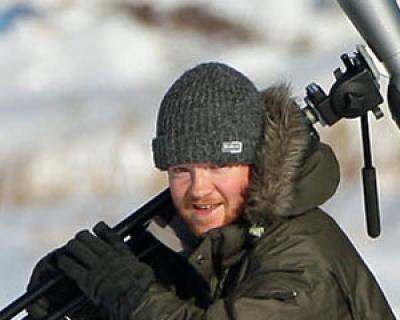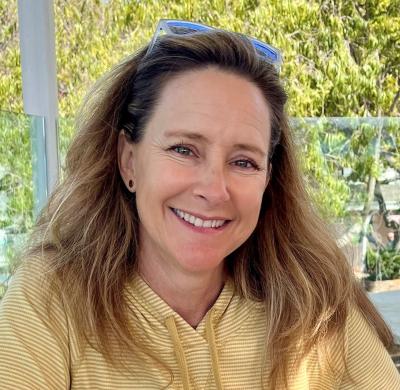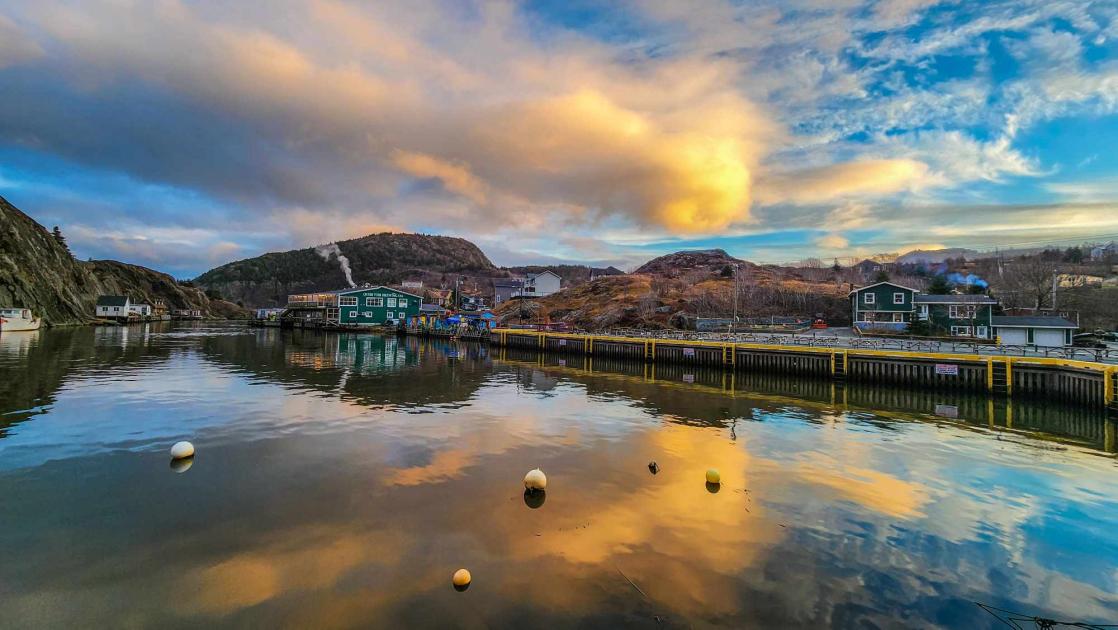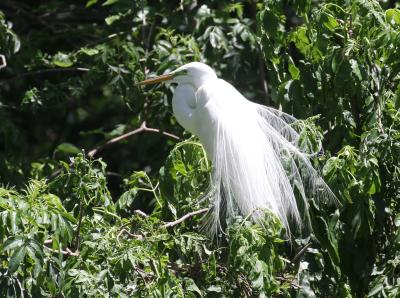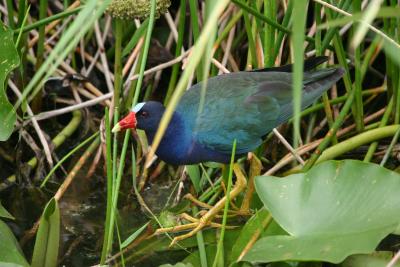Newfoundland: Winter Birds
-
Jan 4-10, 2027
Jared Clarke
Tour Price to be Determined
Tour Price to be Determined
Newfoundland may seem an unlikely winter birding locale but in fact it’s brilliant. With Greenland to the northeast, Iceland and the rest of Europe to the east, mainland North America to the west and South America to the south, Newfoundland is the first or last land that many wayward birds see. Regardless of season, there’s almost always something interesting about, and in winter such wanderers are merely the frosting on a delectable mix of alcids, gulls, and boreal forest birds.
The city of St. John’s, population 150,000, is at the eastern extremity of the province. It’s a charming place to spend a few days and serves well as a base from which to see the region’s birds.
Day 1: Our tour begins this evening with a 6 pm meeting in our comfortable, downtown St. John’s hotel. Night in St. John’s.
Days 2-6: We’ll spend most of our time in and around the city and adjacent parts of the Avalon Peninsula, venturing a bit farther afield should we hear of an interesting bird within driving distance.
We’ll visit Cape Spear, the easternmost point of North America, and other scenic locations along the coastline looking for Great Cormorant, Common Eider, Purple Sandpiper, Dovekie, Thick-billed Murre, and Black Guillemot. January is the best month to see numbers of the charismatic little Dovekie feeding close to shore, often just a few feet off the rocks or next to a wharf where it is possible to watch them swimming underwater in pursuit of tiny crustaceans.
St. John’s may be unsurpassed in North America for the large number and rich diversity of gulls observable in comfort at close range. There are six or more species present daily in winter, including moderate numbers of Lesser Black-backed and Black-headed Gulls, and occasionally a Common Gull. Glaucous Gull occurs in good numbers and “Kumlien’s” Iceland Gull in the thousands in the harbor and at adjacent Quidi Vidi Lake. Some winters there are rarities such as Yellow-legged, Slaty-backed or European Herring Gull.
St. John’s city ponds host significant numbers of wintering Eurasian Wigeon, “Eurasian” Green-winged Teal, and Tufted Duck among the hundreds of American Black Duck and tens of Northern Pintail. The nearby boreal forest is home to resident Boreal Chickadee and northern finches including Pine Grosbeak and White-winged Crossbill. In some winters, Bohemian Waxwing is abundant within the St. John’s city limits, and Gyrfalcon and Snowy Owl are always possible. Winter weather in St. John’s is rarely bitter cold with normal daytime highs at or just above freezing. We can drive to all the good birding locations and will usually be birding near the van.
On at least one day, weather permitting, we’ll visit the southern portion of the Avalon Peninsula, searching for Thick-billed Murre and Razorbill. Among the large Common Eider flocks, mostly of the northern subspecies borealis, we’ll hope to pick out a King Eider. We may stop at feeding stations along our route. They sometimes harbor rarities, mostly from farther south and west, but very occasionally from Europe.
St. John’s, the easternmost city in North America and some would say the oldest in Canada, has considerable Old World charm. Perched on the granite edge of the harbor, it is known for its winding streets lined with colorful houses, and its excellent restaurants and pubs. Given the shortness of January days, those who wish will have ample opportunity to sample town pleasures. The city of St. John’s website is http://www.stjohns.ca/.
Nights in St. John’s.
Day 7: The tour concludes this morning in St. John’s.
Note: The information presented below has been extracted from our formal General Information for this tour. It covers topics we feel potential registrants may wish to consider before booking space. The complete General Information for this tour will be sent to all tour registrants and of course, supplemental information, if needed, is available from the WINGS office.
ENTERING CANADA: U.S. citizens will need a valid passport to enter Canada and return to the U.S. Non-U.S. citizens will need a valid passport and may need tourist visas. Consult your nearest U.S. and Canadian consulates for details. Canadian citizens should carry proof of citizenship in the form of a passport or birth certificate. US citizens must bring proof of citizenship (a passport is now required – any other picture ID such as a driver’s license is no longer accepted).
Your passport, as a general rule, should be valid for at least six months after the date the tour ends. It is always a good idea to take photocopies of your passport and air ticket with you when traveling abroad. They can prove invaluable in helping you get replacements if your original documents are lost or stolen. You should pack the photocopies separately from the originals.
Citizens of other countries may need a visa and should check their nearest Canadian embassy. If required by the embassy or visa-granting entity, WINGS can provide a letter for you to use regarding your participation in the tour.
Typically on the return, you will clear U.S. customs actually in Canada (e.g., Toronto, Montreal, or Halifax), or in Newark, New Jersey, if your flight takes you directly there.
COUNTRY INFORMATION: You can review the U.S. State Department background notes on Canada at http://www.state.gov/r/pa/ei/bgn/2089.htm.
HEALTH: Winter trips have no important health requirements. Sun off snow can be dazzling and we suggest sunglasses. Adequate cold weather clothing is essential for comfort although it is unlikely that temperatures will be so low that frostbite is a major concern. Ears, feet, and hands are the most likely parts of the body to be affected and we suggest a wool hat (or equivalent) that covers the ears, warm gloves, and snow boots worn loosely enough to permit free circulation. Further clothing suggestions are included below.
SMOKING: We request that you do not smoke in the vehicles or when the group is gathered for meals, checklists, etc. If you are sharing a room with a non-smoker, please do not smoke in the room. If you smoke in the field, we ask that you do so well away and downwind from the group. If any lodge, accommodation, or location where the group is staying or gathered has a more restrictive smoking policy than WINGS’ policy, the more restrictive policy will prevail.
CLIMATE: Overnight lows could reach the single digits (F) but temperatures in the teens and 20s are more normal. Daily highs are likely to be in the 20s or 30s, but wind chill can make it feel considerably colder. Snow and/or rain are likely during the course of the tour. At this time of the year, the jet stream passes over Newfoundland, and Atlantic storms are frequent. Travel delays are frequent at this time of the year both getting into and/or out of St. John’s.
PACE OF THE TOUR: The pace of this tour is relaxed. At this time of year at this northern latitude the sun rises relatively late (approximately 7:30 am). Most of our birding is done in close proximity to St. John’s, but on at least one occasion we may have to drive as much as an hour and a half to reach our first birding stop of the day, so we’ll rise early enough to factor in driving time. The sun sets relatively early in the evening (a little before 5:00 p.m.) so our days in the field will not seem especially long and we should be able to turn in early enough each night to afford a good night’s sleep. Breakfasts each day will be sit-down affairs, while lunches will most often be taken in fast food restaurants or small cafés. Barring unforeseen circumstances, suppers will be relaxed sit-down affairs in nice restaurants in St. Johns.
Much of our birding will be done from or very near the vehicle(s) and more time is spent in the vehicles than on most tours. We will try to get out and walk when the opportunity presents itself. We will rotate seats in the vehicle(s) on a daily basis so everyone will have the opportunity to bird from every seat. When not in the vehicle, with few exceptions, birding will be done from plowed roads and walkable trails, almost always near the vehicle itself. Walking will be gentle along plowed roads and trails. Any walks through the snow will be short and will always be optional.
The main controlling element on this tour is the weather which often changes drastically from day to day. Obviously, we won’t be doing much birding if there is a blizzard. It is essential that you bring gear that will keep you warm and dry.
BATHROOM BREAKS: We will have a stop or two during most days when bathrooms will be available. There may be one day when we are further away from any establishments and a restroom break may need to be taken in nature.
ACCOMMODATION: While in St. John’s, we’ll stay at the ALT Hotel, which overlooks the St. John’s Harbour, offering spectacular views of the Narrows and which is also near some of St. John’s best restaurants.
FOOD: WINGS tours are all-inclusive, and no refunds can be issued for any tour meals participants choose to skip. While our restaurants and ground agents make every effort to ensure the comfort of all participants, please note that not all food allergies can be accommodated at every destination. Many restaurants offer set menus and are unable to accommodate all special requests within a group. Thus, clients with significant food allergies or special dietary needs should bring appropriate foods with them for those times when their needs can, regretfully, not be accommodated. Our tours are carefully scheduled to ensure the best possible birding experience. Mealtimes can generally not be adjusted; any participants who need to eat earlier or later than the times scheduled for the group should bring supplemental food with them.
TRANSPORTATION: We’ll use mini-vans for transport as larger vehicles are not at present available.
PHOTOGRAPHY: Excellent photographic opportunities exist on trips in Newfoundland. Bring all your film or extra memory cards with you, as it may be difficult to replenish stocks of the less common types. Long lenses of 300 mm or more are needed for bird pictures. If photography is one of the main reasons you are coming on the trip, please know the pace of a birdwatching tour does not always lend itself to serious photography and we want you to understand the limitations imposed by our schedule. The group will move at the leader’s pace, and may not be able to stay in a location long enough, or move around enough, to get the best lighting or photo.
2025 Narrative
Summary: Our tour was based out of St. John’s – one of the oldest cities in North America and located at its easternmost reaches. A variety of interesting and exciting species can be found around St. John’s during winter, and this year did not disappoint. Rare anywhere else on the continent, we enjoyed dozens of Tufted Ducks and Eurasian Wigeon amid the array of more expected North American waterfowl. Among the abundance of gulls were an ABA-rare Common Gull, several Black-headed Gulls and many Iceland Gulls. Local rarities came from several directions including a Pink-footed Goose from Europe, a Yellow-throated Warbler from further south and lingering Pine and Orange-crowned Warblers.
Travelling outside the city on several occasions, we enjoyed more exciting birds and stunning coastal scenery. Our week started with a flock of 40+ Purple Sandpiper foraging on the wave-battered rocks at the continent’s easternmost point! Dovekie were scarce and required a little extra work, but we managed to spot them on two days. We braved the winter weather to see Purple Sandpipers, Great Cormorants, King & Common Eider and Long-tailed Ducks along with many other northern seabirds. Boreal Chickadees put in several appearances, and a small group of Red Crossbill (of the endemic “percna” race) also popped in for a visit. Keen eyes even picked out two Willow Ptarmigan trying to hide on the wide open tundra. It was a fantastic tour with exciting birds, great people, and a wonderful setting!
January 6: Participants arrived throughout the day with only one notable delay. We met and enjoyed dinner at a restaurant set in a very historic part of downtown St. John’s, getting to know each other and chatting about the great birding ahead!
January 7: We started our birding with a visit to Cape Spear National Historic Site – the easternmost point in North America and a perfect place to spot winter birds. Our first birds were a flock of ~40 Purple Sandpipers foraging on the wave-battered rocks … a big target in the bag after just a few minutes J Just off those same rocks were a mixed flock of Black & White-winged Scoters, Common Eiders and several Long-tailed Ducks. Black Guillemots bobbed up and down in the swell, Iceland and Herring Gulls soared over the crashing waves and two Great Cormorants zipped past the point heading north towards the city. We spotted our first Common Loon and several Red-breasted Mergansers at nearby Maddox Cove, and a lingering Ring-billed Gull (unusual here in winter) on a farm field in Goulds. Our target here, a much rarer Common Gull from Europe, was missing-in-action – but we’d be back!
Back in St. John’s, we took a stroll in beautiful Bowring Park. The duck pond here hosted more than a dozen Northern Pintails (one of the classiest looking ducks around) amongst a myriad of American Black Ducks and Mallards. A mixed flock of songbirds included Dark-eyed Juncos, Black-capped Chickadees and a secretive Brown Creeper – along with two Boreal Chickadees, a real denizen of the northern forests.
Our next stop was at Quidi Vidi Lake – a regular stop that would become very familiar over the next few days. Here, we got acquainted with the array of gulls and ducks that spend the winter around the city. Along with the usual assortment of Herring and Great Black-backed Gulls were dozens of “Kumlien’s” Iceland Gull. Keen eyes were also able to pick out our first Lesser Black-backed Gulls of the trip. Of special note were four Black-headed Gulls – an Old World species that now occurs regularly in Newfoundland and winters on the Avalon Peninsula in small numbers. Everyone found their favourites among the very diverse duck flocks – from the flashy Eurasian & American Wigeons to the understated American Black Ducks, and even the dizzying array of domestic breeds that call the city home. Equally notable was a locally rare Yellow-throated Warbler and a lingering Baltimore Oriole we spotted near the lake, where these southern vagrants were visiting suet feeders placed by caring birders. Not far away, Kenny’s Pond was the current home of several Tufted Ducks, just one of which would be rare anywhere else on the continent. It was a great chance to compare them with some of their North American cousins, the Greater Scaup. Adding to the mix were four smart-looking Hooded Mergansers and five beautiful Bufflehead – somewhat unusual here in the city.
Next, we stopped at Burton’s Pond tucked at the edge of the Memorial University campus. Our prize here was a Pink-footed Goose – a rare visitor from Europe that had been hanging around the city for some time now. This was a lifer and North American “mega” for several in the group! Two very confiding Tufted Ducks were icing on the cake. Our final addition to the day was a group of handsome Green-winged Teal hanging out in a sheltered brook.
January 8: This morning we headed off to explore the “Irish Loop”. This scenic stretch of coast along the southeastern Avalon Peninsula offers not only great birding but also a peek at some of Newfoundland’s earliest European settlements and the ancient geology that makes this island so unique. Our first stops in the snug harbours of Bay Bulls, Witless Bay and Mobile produced a number of Red-breasted Merganser, Common Loons and a surprise Red-throated Loon among others. Black Guillemots were fairly common, but other alcids were eluding us early in the day.
At Ferryland, we were distracted from birding by the intriguing history of the “Colony of Avalon” – site of one of the earliest European settlements in North America (est. 1621). We stepped back in time with a meander through the old village and ongoing archaeological digs. The scenic harbour is lined with rocky islands that gave the community its modern name (Ferryland having been anglicized from the Portuguese “farelhão” meaning steep rocks). A Canada Goose stood out among the variety of ducks in a small wetland here – the only Canada Goose we would see all week!
Continuing south, we stopped at Aquaforte where we connected with our first Dovekie of the trip – a bit distant as it dove and foraged across the narrow bay, but cooperated for everyone to enjoy scope views. A Red-necked Grebe in the same little area was an added bonus. Next up was Renews where we enjoyed lunch overlooking the bay and tidal estuary. Several Harbour Seals peered at us from the water, while Red-breasted Mergansers, Greater Scaup and several Common Goldeneye dove amid the waves. A nearby feeder was relatively quiet, but we did manage to spy several Red Crossbill – the local percna race being both threatened and endemic to Newfoundland so always a treat to see. A locally rare Pine Warbler was also a surprise, even though it had been reported at these feeders for several days.
Driving south along the vast sub-arctic tundra (known locally as “the barrens”), we spotted a young Bald Eagle enjoying its catch, several Common Ravens and a lone Canada Jay perched atop the stunted fir trees. Then we struck gold when Ian spied a snow white Willow Ptarmigan hunkered down behind a rock, trying to hide in plain sight. We ended up with excellent views of a pair as they stood and strolled leisurely across the barrens before flying across the road and into cover.
Heading back north, we stopped at Bear Cove to watch the awesome wave action, along with more than a dozen Common Eiders and several Long-tailed Ducks enjoying the surf.
January 9: We kicked off our morning back at Bowring Park, hoping for a glimpse of the local American Goshawk (it never did appear). Lesa took a short stroll around the pond and spied a Downy Woodpecker – new for the trip!
Heading out of the city to Conception Bay South, a stop at Kelligrews proved both windy and birdy! A flock of Iceland Gulls perched on the rocks provided our best looks and photo opportunities yet. No less than a dozen Black-headed Gulls joined in the frolic, while a much scarcer Bonaparte’s Gull was spotted in the fray. Another lingering Ring-billed Gull was also a surprise. Nearby Holyrood was much quieter, so we headed back towards St. John’s with lunch on our minds. Fortunately, we decided to check the Goulds farm fields again on the way – and this time we lucked out! The Common Gull which had eluded us twice before flew in and joined a few other gulls, provided great looks as it foraged alongside a Ring-billed Gull for excellent comparisons. A great bird, and a lifer for many! Having earned it, we enjoyed a lovely lunch at the Wedgewood Café.
An afternoon visit to Virginia Lake added American Coot to our list – perhaps less than exciting for some, but a rather uncommon visitor in these parts. A stroll along the Rennies River was highlighted by a sighting of an Orange-crowned Warbler – another seasonal rarity visiting local suet feeders. After a quick visit to see the lingering Pink-footed Goose, we headed down the narrow, snaking laneways of “The Battery” – a colourful and very historic neighbourhood perched precariously on the steep cliffs near the harbour entrance. Four Great Cormorants were loafing on a rock just metres from our viewpoint, allowing for fantastic looks and photo opportunities as the sun set over the city behind us.
January 10: With a nice but overcast day in store, our group was excited to return to the southeast Avalon and continue exploring the tundra and rugged coastlines of the “Irish Loop”. We approached the area from the opposite direction as before, heading first to the beautiful and sheltered waters of St. Mary’s Bay. Our first stop at Coote’s Pond found a young Bald Eagle sitting with poise on a large piece of driftwood, overlooking the estuary. The community of St. Mary’s held several surprises, including a locally rare Hooded Merganser, half a dozen Greater Scaup and an unusual-for-winter Swamp Sparrow hanging out in the marsh.
We stepped out into biting winds at the mouth of the bay in Point LaHaye, walking across the exposed headland to peer out in to the open Atlantic. Dozens of Common Eider and Long-tailed Ducks were bobbing up and down on the large waves offshore, while numerous gulls buzzed along the coast. The ocean and long barrier beach (known locally as a barachois or barrisway) at St. Vincent’s was somewhat quiet, although numerous Common Loons and Black Guillemots were hanging out offshore. Leaving here, we flushed a flock of ~30 Snow Buntings off the roadside as we drove once again into the vast, rolling tundra that dominates the southern tip of this peninsula.
Next we visited St. Shott’s, a quaint but barren community at the southernmost tip of Newfoundland. Driving along the barrens to get there, we spotted several Woodland Caribou – the most southerly herd of these mostly arctic animals in the world. While they stayed well in the distance, we were able to enjoy prolonged scope views as they foraged and feasted on the abundant lichens that make up most of their very specialized diet. We enjoyed our own lunch atop the cliffs, overlooking the very active ocean that loomed below us. Two Dovekie appeared briefly in the foaming surf, then picked up and flew off over the breaking waves. An American Pipit called out as it zipped by, and dozens of Common Eider were dotted on the swells. A few of us walked down to the cliff edge, spotting three Harlequin Ducks in the water just east of the point.
Our next stop in Trepassey offered up our only Surf Scoters of the week – a flock of eight feeding in the calmer waters of this large and sheltered harbour. This town, once a busy outport and fishing community, has seen challenging days since the crash of the cod fishery thirty years ago – but perseverance and spirit have gotten those who remain through another generation and tourism (especially birding) is growing in the region.
Before calling it a day, we headed out to one of my favourite destinations in the province – Cape Race National Historic Site. Here stands a historic and imposing lighthouse – once one of the most important navigational points in eastern North America, and site of the wireless station that was communicating with the Titanic as it sank 113 years earlier. Flocks of Common Eider, Long-tailed Ducks and 50+ White-winged Scoter were hanging out below the light, and the dramatic cliffs and stunning scenery at this location was the real showstopper. Three Red-necked Grebe at the nearby “Drook” added to our tally as we headed north and back to St. John’s.
January 11: We started our final day with a return visit to Cape Spear National Historic Site – stopping along the way to enjoy some cooperative Boreal Chickadees in the nearby village of Blackhead. After walking down to the point at Cape Spear, we were able to spot a female King Eider mixed in with a group of Common Eiders, Black & White-winged Scoters – a wonderful surprise and one of the target species we had missed earlier in the week.
Arriving back in the city, we stopped at Mundy Pond where we got our best and closest looks at several Tufted Ducks, along with our first Ring-necked Ducks of the tour. A visit to Kelly’s Brook turned up ~25 Green-winged Teal, but not the “Eurasian” race that we had hoped for (that would have to wait just a couple hours). Quidi Vidi Lake was home to the usual suspects, including four Black-headed Gulls and a nice mix of American & Eurasian Wigeon. An immature Ring-billed Gull was a new arrival – notably, our third of the week. Before heading to lunch, we checked back in on the Great Cormorants in “The Battery” – there were now five, and they posed for photos in even better light than a couple days previous.
After lunch, we drove north of the city to the outports of Outer Cove, Middle Cove, Torbay and Flatrock where the rolling seas were as intriguing as the birds. Black Guillemots fed in the surf along with numerous Red-breasted Mergansers, several Common Loons and some very attractive Iceland Gulls.
Following a hot tip, we stopped in at Virginia Lake on our way back into the city. Here we found the elusive “Eurasian” Green-winged Teal that had been avoiding us all week – a handsome but shy bird that took a little work to see well before flying out into the middle of the lake. We checked Kenny’s Pond and Quidi Vidi Lake one more time in hopes of spotting some new birds, but eventually found one – a lovely Glaucous Gull – in St. Johns harbour as the sun began to set. A fine way to end a great week of birding at the eastern edge of Canada!
January 12: Folks departed throughout the morning, heading off in the various directions of “home”. I know everyone left with several “life birds” under their belt, some fabulous birding experiences, and hopefully warm memories of our cold northern winter. It was a wonderful week spent with great people, fantastic birds and all in a beautiful place!
Species: 66 (+ several hybrids, subspecies and an array of domestic duck breeds!)
- Jared Clarke, 2025
Jared was an excellent leader. Not only did he find great views of the birds, he also answered my many questions about the different species and subspecies. Very informative. I really appreciated how Jared also shared the history and geology of St. John’s and the beautiful Avalon peninsula, giving us a better understanding of his “backyard”. I would go on a tour with him again, for sure!
- Jayne B. on Newfoundland: Winter Birds
Jared Clarke is a tremendous leader. Newfoundland birding and Jared Clarke are a combination for great fun.
- Michael S. on Newfoundland: Winter Birds
I have been out with some very good birding leaders who lead for Wings and other companies. Jared was the best. Not only did he know where to find birds, including a Northern Goshawk, he was great at getting everyone the looks they wanted. The Snowy Owl at the end was the best of all. I'd go birding with Jared anywhere.
- Kathy M. on Newfoundland: Winter Birds
Jared did a great job of being flexible and tailoring our day trips to meet our objectives (seeing target birds) as the weather was constantly changing. His knowledge of the birds of Newfoundland, and North America in general, facilitated our ability to find and enjoy the birds. His overall knowledge of, and enthusiasm, for Labrador and Newfoundland greatly enhanced the experience.
- Lea L. on Newfoundland: Winter Birds
Newfoundland birding and Jared Clarke are a combination for great fun.
- Michael S. on Newfoundland: Winter Birds
Maximum group size 5 with 1 leader.




























